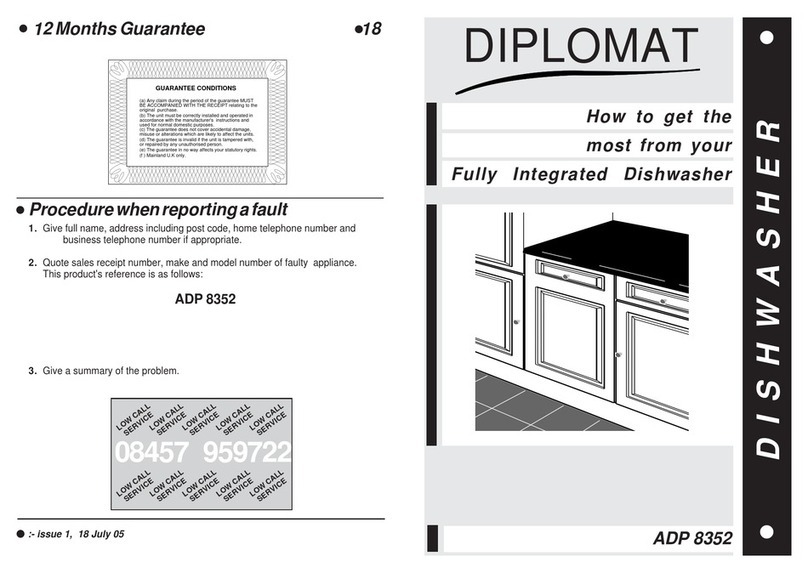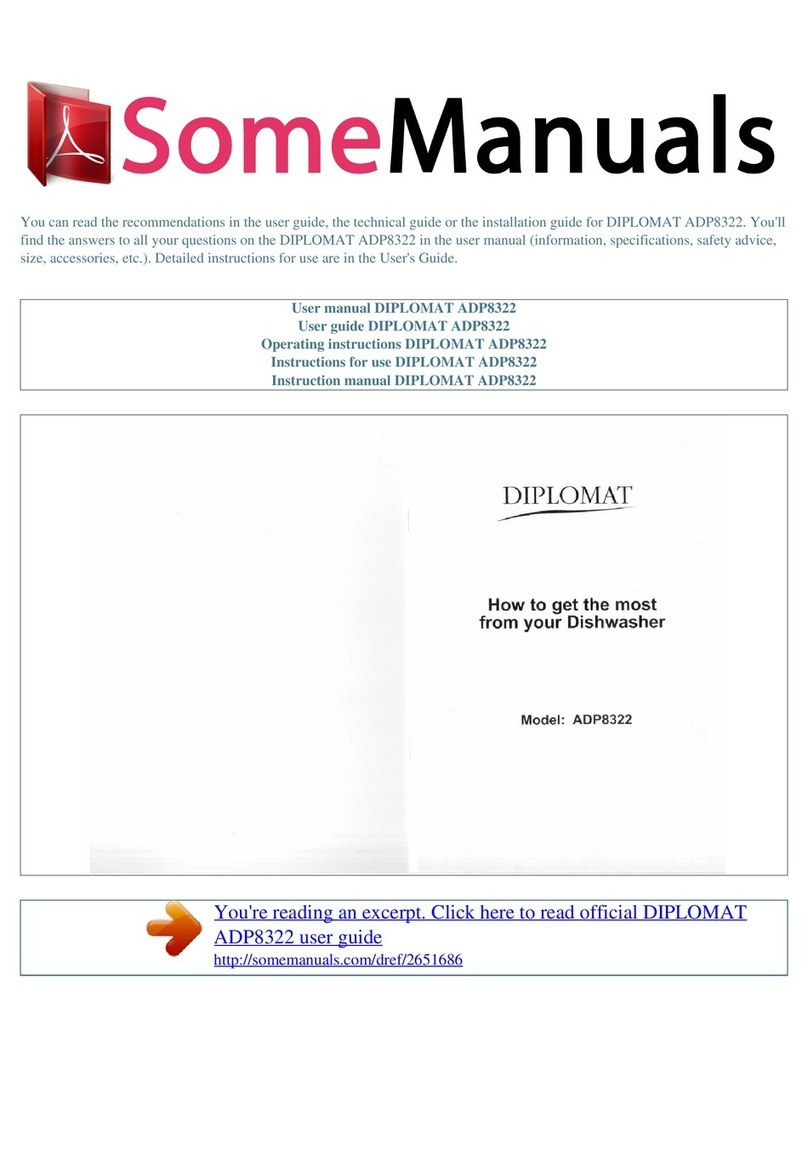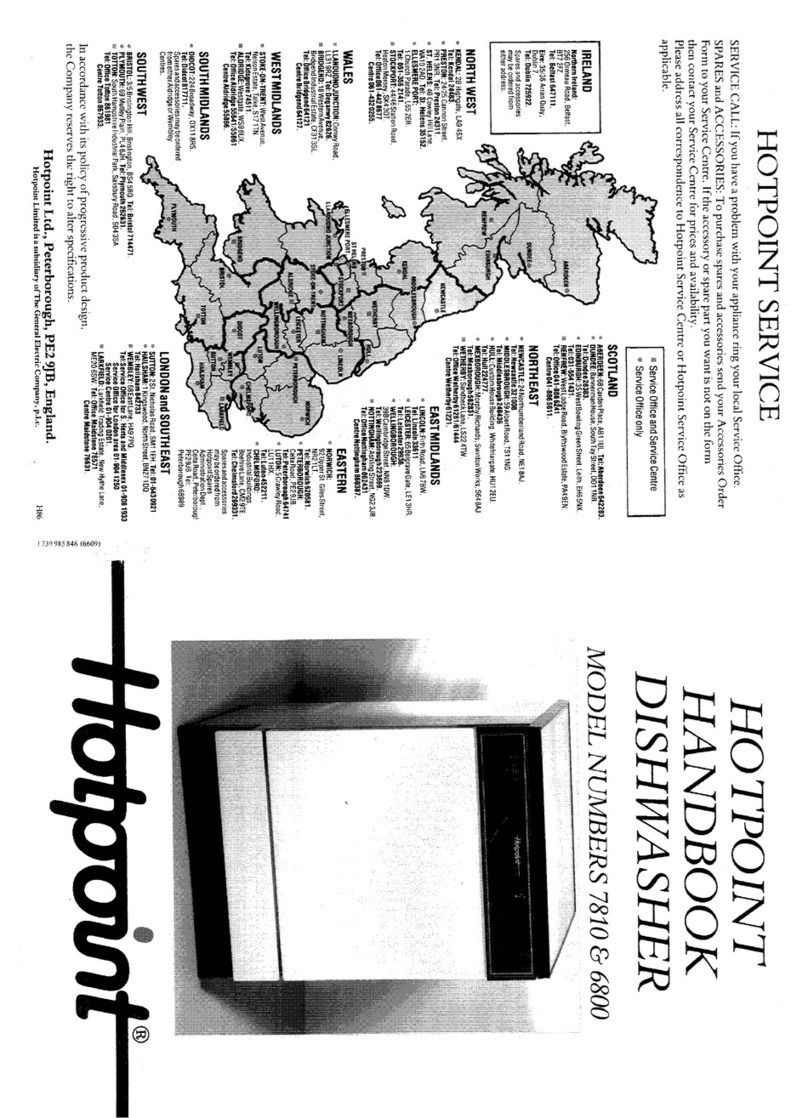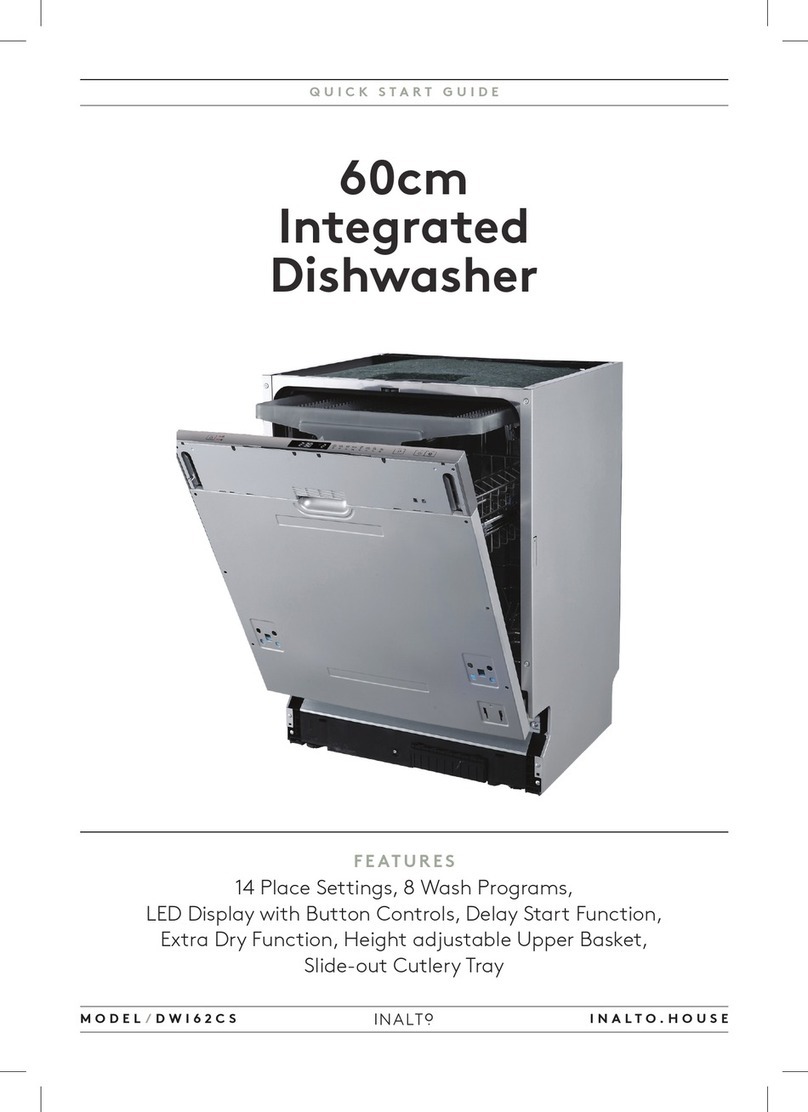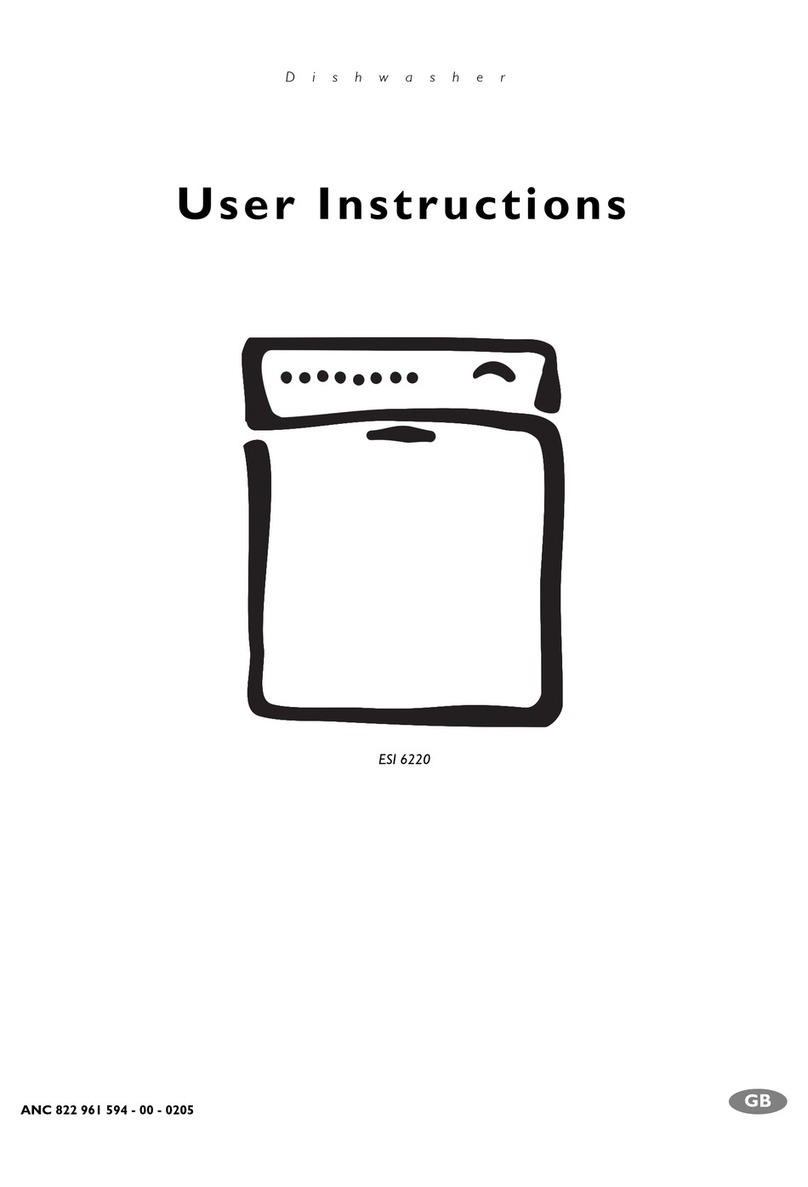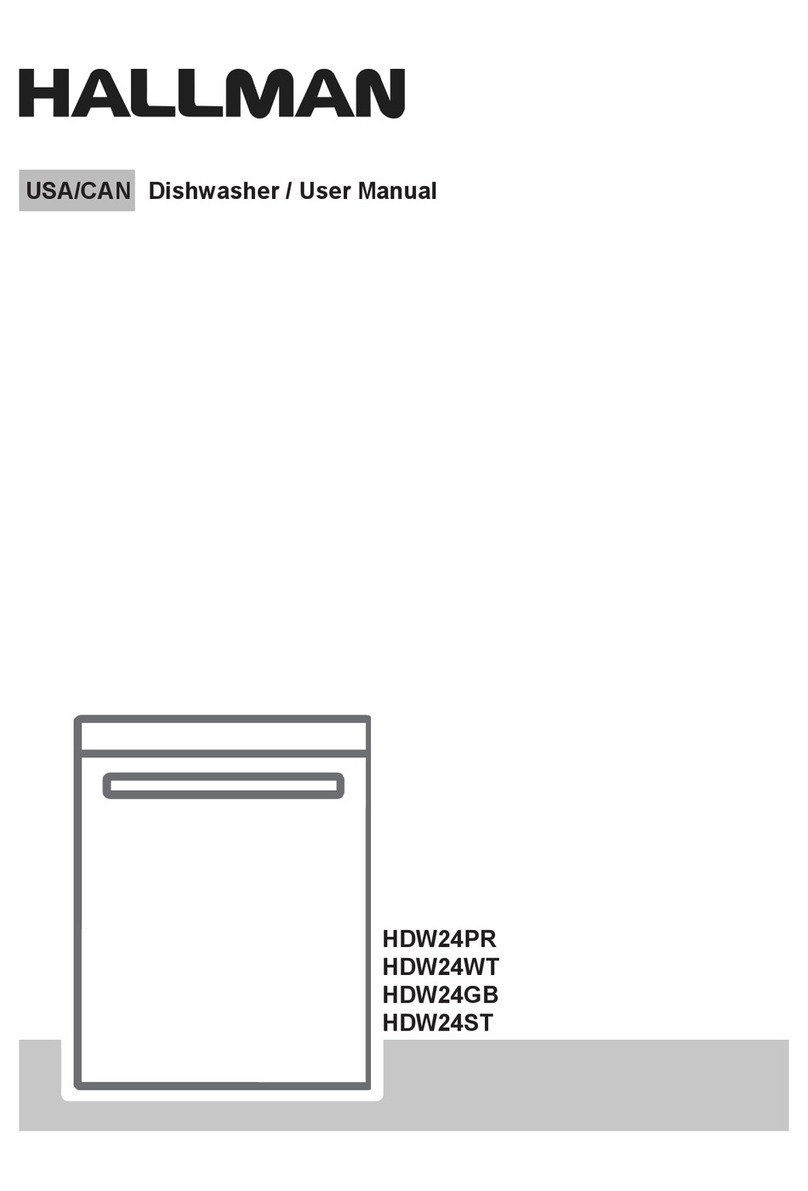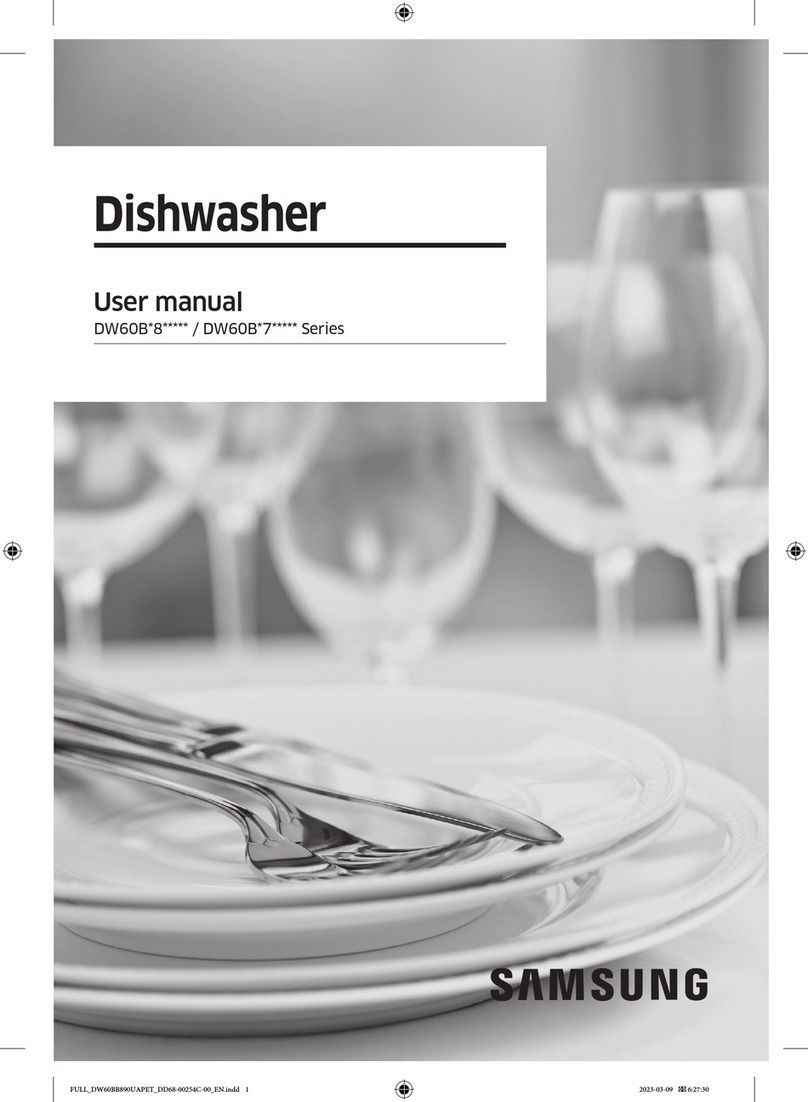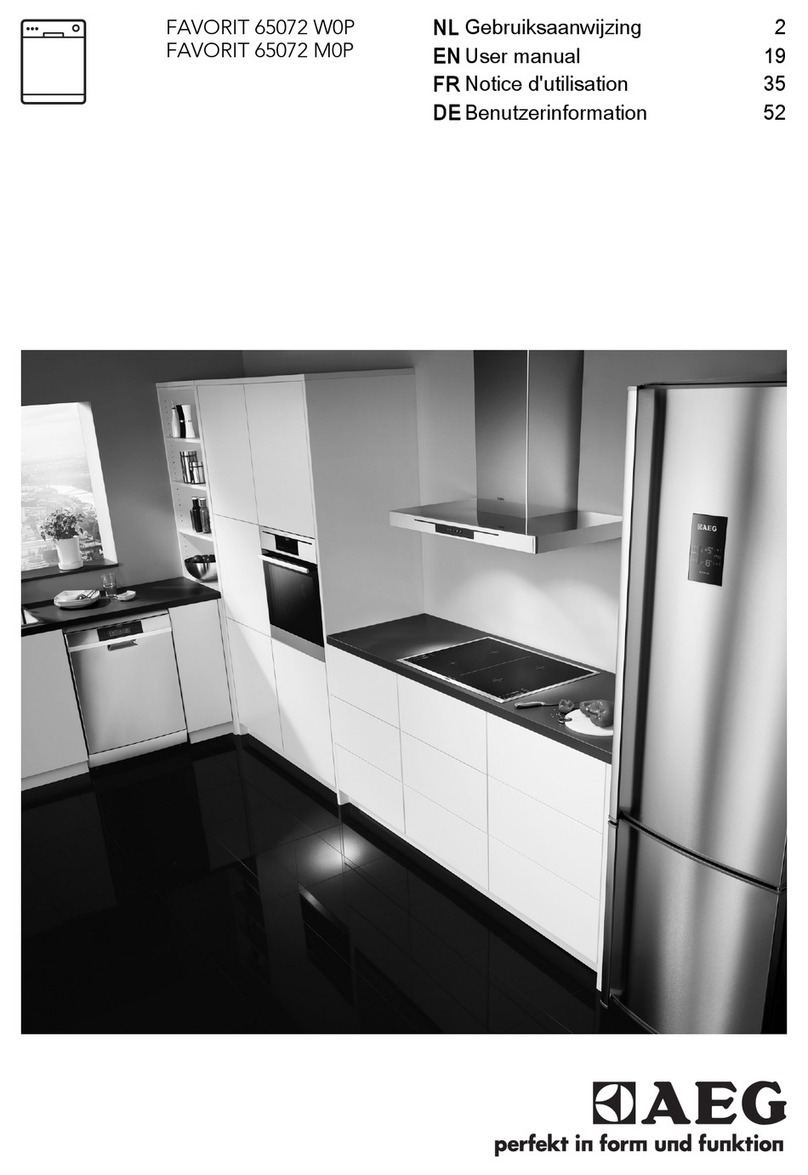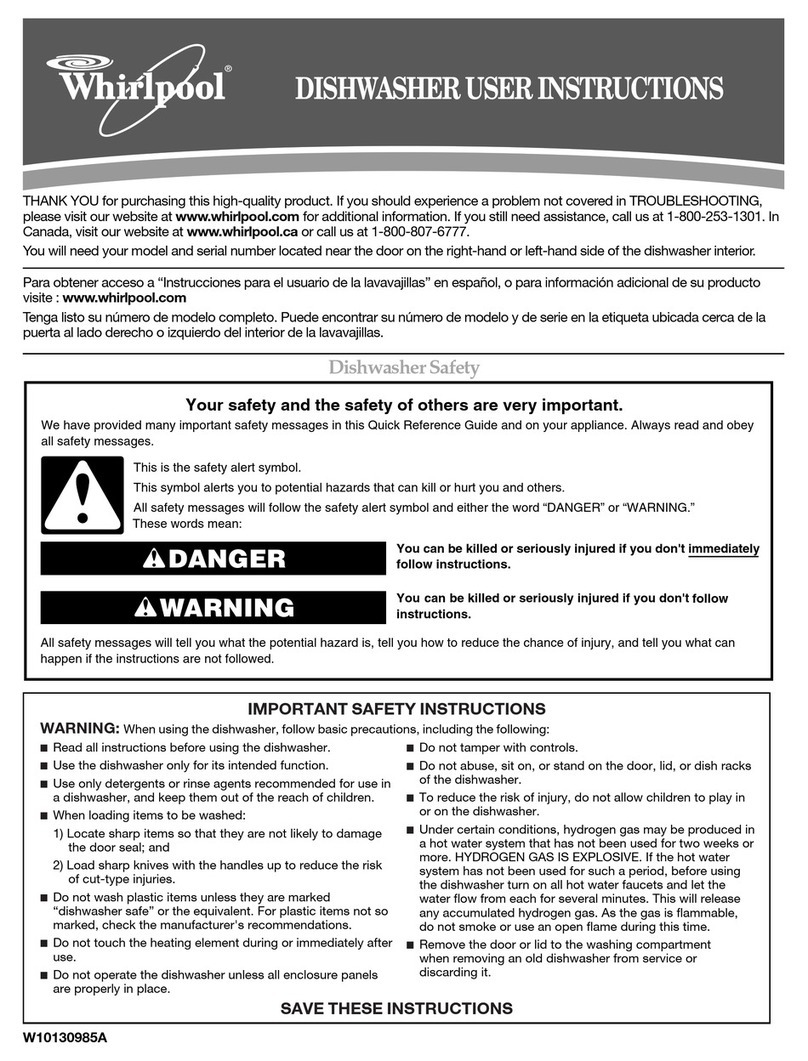Diplomat ADP8152 Quick start guide

DISHWASHER
INSTALLATION AND USE
ADP8152
NOTES

DECLARATION OF CONFORMITY
The manufacturer of the product/s described herein, to which this description refers, declares on its sole responsibility that the
product/s meet the relevant fundamental satety, health and protection requirements of the relevant EU guidelines and that corre-
sponding test reports are available for examination by the relevant authorities and can be requested from the seller of the appliance ,
especially with regard to CE Declaration of Conformity issued by the manufacturer or with the manufacturer's approval.
Moreover, the manufacturer declares that the parts of the appliance described in this user manual, which come into contact with fresh
food, do not contain any toxic substances.
Please keep this handbook for future reference or for anyone else who may use this appliance.
.1.
NOTICE
Carefully read the instructions contained in this manual,as they
provide importion which is essential to safe and proper installation,
use and maintenace of the appliance.
This appliance complies with the following EEC
directives:
-73/23/EEC of 19/02/73(Low Voltage)and subsequent
modifications;
- 89/336/EEC of 03/05/89 (Electromagnetic
Compatibility) and subsequent modifications.
- Carefully dispose of the packing material.
- After removing the packing,check to make sure that the appli-
ance is not damaged.If in doubt,contact a qualified professional.
- The dishwasher must only be used by adults for the washing of
household dishes and cooking utensils.
- Fundamental rules to follow when using the appliance:
* Do not use extension cords or multiple sockets;
* During installation,the power supply cord must not be exces
sively or dangerously bent or flattened;
* If the appliance is not operating properly, or, maintenance must
be performed,disconnect the appliance from the power supply.
Safety Is a Good Habit to Get Into
- Keep detergents out of the reach of children,who must also be
kept away from the dishwasher when it is open.
- This appliance cannot be installed outdoors,not even if the
area in which it is installed is covered by a roof;it is also very
dangerous to leave it exposed to the rain and elements.
- Do not touch the heating element during or after a wash cycle.
- Do not lean or sit on the door when it is open ,as this could
overturn the dishwasher.
- Do not use solvents of any kind inside your dishwasher. They
could cause an explosion.
- If the appliance malfunctions,turn off water supply to the appli
ance and disconnect the plug from the wall socket.Then,con
sult the section entitled, "Troubleshooting."If you cannot re
solve the problem,contact a service centre.
- Only specialised personnel are authorised to make repairs.
- Appliances which are no longer being used must be made
inoperable by cutting the power supply cord and removing the
the plugs from the socket .
- The appliance must be positioned so that the plug is accessible.
- The carpet must obstruct the opening when the appliance is in
stalling on the ground with carpet.
- If the supply cord is damaged , it must be replaced by a
special cord or assembly available from the manufacturer or
its service agent.
Close-up View (Control Panel)
A
B
C
D
E
ON-OFF Light
ON-OFF Button
Low Salt Indicator Light
Low Rinse Aid Indicator Light "RAPID"Button
F
G
H
I
"Eco" Button
"HALF LOAD" Button
A B C D
I H G FE
Knob For Selecting Program
Handle For Opening Door
○○○○○○○○○○○○○○○○○○○○
1
Safety Is a Good Habit to Get Into
Close-up View (control panel)
○○○○○○○○○○○○○○○○○○○○○○○○
1
Close-up View (Interrior)
Salt
○○○○○○○○○○○○○○○○○○○○○○○○○○○○
2
○○○○○○○○○○○○○○○○○○○○○○○○○○○○○○○○○○○○○○○○○○○○
3
Detergent and Rinse Aid
Loading the Dishwasher
○○○○○○○○○○○○○○○○○○○○○○○○○○○
○○○○○○○○○○○○○○○○○○○○○○○○○○○○○
4
5
Turning on the Appliance
Wash Cycle adjustment Buttons
○○○○○○○○○○○○○○○○○○○○○○○○○○○○○
6
○○○○○○○○○○○○○○○○○○○○○
6
How to Keep Your Dishwasher in Shape
○○○○○○○○○○○○○○○○○○○○○○○○○○○○○○○○○
○○○○○○○○○○○○○○○○
7
8
Cleaning and Special Maintenance
Troubleshooting
○○○○○○○○○○○○○○○○○○○
8
○○○○○○○○○○○○○○○○○○○○○○○○○○○○○○○○○○
9
Installation
○○○○○○○○○○○○○○○○○○○○○○○○○○○○○○○○○○○○○○○
9
CONTENTS
Energy Saving Tips
10
○○○○○○○○○○○○○○○○○○○○○○○○○○○○○○○○○○○
Electrical Safety Instruction
○○○○○○○○○○○○○○○○○○○○○○○○○○○○
12
R
1
4
3
2
5
ON
OFF
1
2
12345
S
Wash Cycle Table

.2.
Close-up View (Interrior)
A
B
C
D
Upper Rack
Rack Height Adjustor
Top Sprayer Arm
Lower Rack
E
F
G
H
I
Washing Filter
Bottom Sprayer Arm
Detergent and Rinse Aid Dispenser
Third Sprayer
Technical characteristics
Width 60 cm
Depth 60 cm
Height 85 cm
Capacity 12 standard place settings
Mains water pressure Minimun30Kpa / Maxmun6Kpa
Voltage 220-240V~ 50Hz
2100W
Total power
Salt Container Cap
.3.
Salt
Salt
The hardness of the water varies from place to place. If hard
water is used in the dishwasher,deposits will form on the dishes
utensils.
The appliance is equipped with a special softener that uses a salt
specifically designed to eliminate lime and minerals from the water.
Loading the Salt into the Softener
Always use salt intended for use with dishwashers.
The salt container is located beneath the lower rack and should
be filled as follows:
- Remove the lower rack , unscrew and remove the cap
from the salt container;
- If you are filling the container for the first time, fill it with water;
- Place the end of the funnel(supplied) into the hole and intro-
duce about 2 kg of salt.It is normal for a small amount of water
to come out of the salt container.
- Carefully screw the cap back on.
The salt container must be filled when the "low salt" indicator
light (located on the control panel),comes on.
.
To prevent the formation of rust,load the salt just before be-
ginning a wash cycle.
Adjusting Salt Consumption
The dishwasher is designed to allow for adjusting the amount of
salt consumed based on the hardness of the water used.This is
intened to optimize and customize the level of salt consumption
so that it remains at a minimum.
To adjust salt consumption,proceed as follows:
- Unscrew the cap from the salt container;
- There is a ring on the container with an arrow on it (see figure to
the side),
- If necessary, rotate the ring in the anticlockwise direction from
the "-" setting towards the "+" sign,based on the hardness of
the water being used.
It is recommended that adjustments be made in accordance with
the following scheme:
Water Hardness
Clarke
detergent dH mmol/l Selector
position
Salt
consumption
(Grams/cycle)
Autonomy
(cycles\2kg)
014

.4.
Detergent and Rinse Aid
Detergent
Detergent specifically intended for use with dishwashers must
be used.The dispenser must be refilled before the start of each
wash cycle following the instructions provided in the "Wash Cycle
Table."The detergent dispenser is located on the inside panel
the door.
Loading the detergent
To open the "A" cover on the dispenser,press the "B" button.The
detergent for the wash cycle should be poured into the "C"
compartment.
After the detergent has been placed in the dispenser, close the
cover and press down until it clicks in place.
Notice:To facilitate closing the cover, remove any excess
detergent on the edges of the dispenser.
Rinse Aid
This product makes dishes sparkle and helps them to dry with-
out spotting.The dispenser is located on the inside panel of the
door and should be filled after every 80 wash cycle(or when the
rinse aid indicator light comes on for those models with this
feature).
Loading the Rinse Aid
To open the dispenser,turn the "C" cap in the anti-clockwise
dierction and then pour in the rinse aid,making sure not to overfill.
The amount of rinse aid used for each cycle can be regulated by
turning the "F" dose adjustor ,located beneath the "C" cap, with
a screwdriver.There are 6 different settings; the normal dosage
setting is 3.
Important
Proper dosage of the rinse aid improves drying.
If drops of water remain on the dishes or spotting occurs,the
dosage adjustor should be turned to a higher setting.
If the dishes have white streaks,turn the dosage adjustor to a
lower setting.
C
B
A
C
C
F
.5.
Loading the Dishwasher
Before placing the dishes in the dishwasher, remove the large food
particles to prevent the filter from becoming clogged,which results
in reduced performance.
If the pots and pans have baked-on food that is extremely hard to
remove, we recommend that they be allowed to soak before they
are washed.This will eliminate the need for extra wash cycles.
Pull out the rack to facilitate loading the dishwasher.
How to Use the Lower Rack
We recommend that you place the most difficult to clean items on
the bottom rack:pots ,lids,serving dishes and bowls,as shown in
the figure on the right.
It is preferable to place serving dishes and lids on the sides of the
racks in order to avoid blocking the rotation of the top spray arm.
- Pots,serving bowls,etc.must always be placed top down.
- Deep pots should be slanted to allow the water to flow out.
- The silverware basket can be doubled(see Fig. A) so that only
one section may be used when the silverware load is light. this
also makes space for additional pots and pans,and it can also be
placed in the upper rack.
- Silverware should be placed in the silverware basket with the
handles at the bottom;if the rack has side baskets,the spoons
should be located individually into he appropriate slots.Especially
long utensils should be placed in the horizontal position at the
front of the upper rack.
How to Use the Upper Rack
The upper rack is designed to hold more delicate and lighter
dishware,such as glasses,coffee and tea cups and saucers,as well
as plates,small bowls and shallow pans(as long as they are not
too dirty).
Position the dishes and cookware so that they do not get moved
by the spray of water.
The upper rack can be adjusted for height . (See Fig. B)
Lower Rack Upper Rack
Load for 12 Standard Settings
Fig.A Fig.B
2
1
34

Wash Cycle Table
Cycle Eco
Button RAPID
Button Cycle Selection
Information Desciption of
Cycle Deter-
gent Rinse
Aid
Normal Wash
6
Normal Wash
Light Wash
6
Rinse
Glassware
Glassware
Soak
Normally dirty dishes,pots
and pans.Standard daily
cycle.
Very dirty dishes,pots and
pans.(not to be used with
delicate items)
Normally dirty dishes,pots
and pans without dried on
residue.
For dishes that need to be
rinsed and dried only.
Economic,fast cycle to be
used for items which are sen-
sitive to higher.Run immedi-
ately after dishes are used.
Economic,fast cycle to be
used for items which are sen-
sitive to higher.Run immedi-
ately after dishes are used.
Pre-wash of dishes, pots and
pans while waiting for the load
to be complete after the sub-
sequent meal.
Pre-wash with hot water.
Extended wash at 65
Rinse with cold water.
Rinse with hot water at 70
Drying.
Pre-wash with cold water.
Extended wash at 55
Rinse with cold water.
Rinse with hot water at 70
Drying.
Extended wash at 65
Rinse with cold water.
Rinse with hot water at 70
Drying.
Rinse with cold water.
Rinse with hot water at 70
Drying.
Wash at 55
Hot Rinse at 65
Drying.
Wash at 55
Rinse with cold water.
Short cold wash to pre-
vent food residue from
drying on the dishes
30g
30g
25g
15g
15g
.6.
Turning on the Appliance
Starting a wash cycle
- Make sure that the plug for the appliance is inserted into the wall
socket.
- Make sure that the water supply is turned on to full pressure.
- Load the dishwasher (see the section entitled,"Loading the
Dishwasher").
- Pour in the detergent (see the section entitled,"Salt,Dergent and
Rinse Aid").
- Turn the knob located on the right of the control panel in the
clockwise direction until the number or symbol for the cycle set
ting is aligned with the reference mark(see the section entitled,
"Wash Cycle Table").
- Press the ON-OFF botton,and the ON-OFF light will turn on.At
this point,the wash cycle will begin.
Cancelling or modifying a wash cycle setting
Premise:A cycle that is underway can only be modified if it has
only been running for a short time.Otherwise, the detergent may
have already been used,and the appliance mayhave already
drained the wash water>If this is the case,the detergent dispenser
must be refilled(see the paragraph entitled,"Loading the
Detergent").
Press the ON-OFF button,and the ON light will turn off.Rotate
the knob in the clockwise direction to the desired cycle setting
(see the section entitled.:Starting a wash cycle
If you forget to load some of the dishes
The wash cycle can be interrupted by pressing the ON-OFF button.
You can then load additional dishes and turn the appliance back
on.The cycle will start where it left off.
Wait a few minutes before unloading the dishwasher to avoid
handling the dishes and utensils while they are still hot and more
susceptible to breakage.They will also dry better.
Wash Cycle Adjustment Buttons
"ECO" Button
This button(see "close-up View - Control Panel",letter"G")is used
for the normally dirty dishes,pots and pans.It is standard daily
cycle.
"1/2 load" Button
This button(see "close-up View - Control Panel",letter"H") make
it possible to wash dishes using only the upper rack if there are
not enough dishes for a full load.This will allow you to save on
water and eletrical energy.
"Rapid" Button
This button(see "close-up View - Control Panel",letter "I") ,when
pressed with wash cycle 4(glassware) make it possible to run
the wash cycle at a lower temperature
(50 ) and eliminates the drying phase.
It can be used before setting any of the wash cycles, except for
the intensive cycles (if included in the wash cycle table ). Please
keep in mind that the amount of degertent should also be cut in
half.
Important: In general, it is not advisable to open the door
while the machine is working. Care must be taken if the
door is opened during the hot phase or immediately after a
program has finished as steam may escape.
1
4
3
2
5
.7.
At the end of the wash cycle
When the knob stops turning (see figure), the cycle has finished.
When the washing program has finished ,it is recommended that
the dishwasher is unplugged and the water is turned off.

.8. .9.
Cleaning and Special Maintenance
Filter Assembly
For best performance and results, the filter assembly must be
cleaned.
The filter efficiently removes food particles from the wash water,
allowing it to be recirculated during the cycle.For this reason ,it is
a good idea to remove the larger food particles trapped in the
filter after each wash cycle by rinsing the"A"semi-circular filter
and cup under running water.To remove the filter assembly,pull
on the cup handle in the upward direction. The entire filter as-
sembly (made up of the "A" semicircular filter and the"B" fine
filter)should be cleaned at least once a month.To clean the filter
and the fine filter,use a cleaning brush .Then,reassemble the fil-
ter parts as shown in the figures below and reinsert the entire
aseembly in the dishwasher,positioning in its seat and pressing
downward.
The dishwasher must not be used without the filters.Improper
replacement of the filters may reduce level of the appliance and
damage dishes and utensils.
Cleaning the Spray Arms
It may happen that food particle become encrusted on the sprayer
arms and block the hole (see "Close up view [interior]",letters C-
F ).Check the sprayer arms periodically and clean them when
needed.
It may occur that the dishwasher does not function or does not
function properly.Before calling for assistance,Iet us see what
can be done first:have you forgot to press one of the buttons or
to perfom an essential operation?
The Dishwasher Does Not Start
Have you checked whether:
- the plug is pushed into the socket correctly;
- the power is on in the house;
- the door is closed properly;
- the ON-OFF switch is on "ON";
- the water supply is turned on.
The Dishwasher Does Not Load Water
Have you checked whether:
- the water is turned on and the hose is connected properly;
- the water supply to the house on and has sufficient pressure;
- the water supply hose is crimped or bent;
- the filter for the water supply hose is clogged.
The Dishes Are Not Clean
Have you checked whether:
- the water is turned on and the hose is connected properly;
- the water supply to the house on and has sufficient pressure;
- the water supply hose is crimped or bent;
- the filter for the water supply hose is clogged.
The Dishwasher Does Not Drain
Have you checked whether:
- the drain hose is crimped or bent.
Lime Deposits or a White Film Form on the Dishes
Have you checked whether:
- the lid to the salt container is closed properly;
- the rinse aid dosage is correct.
If,despite all these checks,the dishwasher still does not function
and/or the problem persists,contact the nearest authorised service
centre and provide them with the following information:
- the nature of the problem;
- the model type number (Mod...)and the serial number (S/N...),
which are indicated on the plate located on the side of the inner
part of the door.
Never call on unauthorised technicians and refuse to al-
low parts to be installed that are not original spare parts.
Troubleshooting
CAUTION
Do not forget that repairs should only be carried out by a quali-
fied specialist.
A
B
- It is important to try and run the dishwasher when it is fully
loaded to save on energy.In order to prevent odors from form-
ing and food from caking onto the dishes,you can run the hold
cycle.
- Choose the right wash cycle: the choice of cycle depends on
the type of dishware, cookware and utensils being washed and
how dirty they are.
Energy Saving Tips
- Use the right amount of detergent: if you use too much detergent,
the result will not be cleaner dishes,but,rather,a greater nega
tive impact on the environment.
- There is no untility in rinsing dishes ,cookware and untensils
before placing them in the dishwasher.
How to Keep Your Dishwasher in Shape
After Every Wash
After every wash, turn off the water supply to the appliance and
leave the door slightly ajar so that moisture and odors are not
trapped inside.
Remove the Plug
Before cleaning or performing maintenance, always remove the
plug from the socket.Do not run risks.
No Solvents or Abrasive Cleaning Products
To clean the exterior and rubber parts of the dishwasher, do not
use solvents or abrasive cleaning products.Rather, use only a
cloth and warm soapy water.
To remove spots or stains from the surface of the interior, use a
cloth dampened with water and a little white vinegar,or a clean-
ing product made specifically for dishwasher.
When You Go on Holiday
When You Go on Holiday,it is recommended that you run a wash
cycle with the dishwasher empty and then remove the plug from
the socket ,turn off the water supply and leave the door of the
appliance slightly ajar.This will help the seals last longer and pre-
vent odours from forming within the appliance.
Moving the Appliance
If the appliance must be moved,try to keep it in the vertical position.
If absolutely necessary,it can be positioned on its back.
Seals
One of the factors that cause odours to form in the dishwasher is
food that remains trapped in the seals.Periodic cleaning with a
sponge will prevent this from occuring.

.10.
Installation
Positioning the Appliance
Positioning the appliance in the desired location.The back should
rest against the wall behind it,and the sides,along the adjacent
cabinets or wall.The dishwasher is equipped with water supply
and drain hoses that can be positioned to the right or the left to
facilitate proper installation.
Levelling the Appliance
Once the appliance is positioned,adjust the feet (screwing them
in or out) to adjust the dishwasher,making it level.In any case,
the appliance should not be inclined more than 2 .If the appli-
ance is level,it will help ensure proper performance.
Cold Water Connection
Connect the cold water supply hose to a threaded 3/4(gas)con-
nector and make sure that it is fastened tightly in place (see
figure1).
If the water pipes are new or have not been used for an extended
period of time,let the water run to make sure that the water is
clear and free of impurities.If this precaution is not taken,there is
a risk that the water inlet can get blocked and damage the
appliance.
The connection must be made to the hot water line following the
same procedures as those for the connection to the cold water
line.
Anti-Flooding Protection
The dishwasher is equipped with a system that stops the supply of
water in the event of a problem with the water supply hose,or leaks
within the unit,in order to prevent damage from your home.In
order to guarantee that the anti-flooding feature operates properly,
the water supply hose must be attached to the water supply tap
as shown in Fig .1. The water supply hose must not,under any
circumstances,be cut,as it contains electrical parts which are live.
Drain Hose Connection
Insert the drain hose into a drain pipe with a minimum diameter
of 4cm,or let it run into the sink,making sure to avoid bending or
crimping it.Use the speical plastic support that comes with the
appliance (see Fig.2).The free end of the hose must be at a
height between 40 and 100 cm and must not be immersed in
water.
Attention:
The special plastic hose support must be solidly fastened to the
wall to prevent the drain hose from moving and allowing water to
spill outside the drain.
Electrical Connection
After making sure that the voltage and frequency values for the
current in the home correspond to those on the rating plate
insert the plug into an electrical socket which is earthed properly.
(This appliance must be earthed.)
Hot Water Connection
The water supply to the appliance can also be connected to the
house's hot water line (centralised system,heating system),as long
as it does not exceed a temperature of 60 .
In this case,the wash cycle time will be shortened by about 15
minutes and the wash efficiency slightly reduced.
Important: Any electrical or plumbing work required to in-
stall this appliance, should be carried out by a qualified
electrician or qualified plumber.
Ensure that the plug is accessible after installation.
Fig.2
Fig.1
Alternative drain hose connection to the sink outlet siphon,securing it with a cup if necessary.The sink plug must not be in place when the
machine is draining,as this could cause the water to siphon back into the machine.
.11.
Installation

.12.
Electrical Safety Instruction
WARNING!
THIS APLIANCE MUST BE EARTHED
IF THE MAINS LEAD OF THE APPLIANCE IS FITTED
WITH A PLUG:
Fuse replacement
If the mains lead of this appliance is fitted with a BS
1363A 13 amp fused plug, to change a fuse in this type of
plug use an A.S.T.A. approved fuse to BS 1362 Type and
proceed as follows:
1. Remove the fuse cover (A)
2. Remove the fuse(B)
3. Fit replacement fuse into plug
4. Refit the fuse cover
IMPORTANT
The fuse cover must be refitted when changing a fuse and if
the fuse cover is lost the plug must not be used until a correct
replacement are identified by the colour insert or the colour
embossed in words on the base of the plug. Replacement fuse
covers are available from your local electrical store.
CONNECTION TO A REWIREALE PLUG
If the fitted plug is not suitable for your socket outlet, then it should
be cut off and disposed of order to avoid a possible shock hazard
should it be inserted into a 18A socket elsewhere. A suitable alter-
native plug should then be fitted to the cable.
The wires in this mains lead are coloured in accordance with the
following code:
BLUE "NEUTRAL" (N)
BROWN "LIVE" (L)
YELLOW & GREEN "EARTH" (E)
1.The YELLOW & GREEN wire must be connected to the terminal
in the plug, which is marked with the letter "E"
or by the Earth symbol
or coloured green or green and yollow.
2.The BLUE wire must be connected to the terminal which is marked
with the letter "N" or coloured black.
3.The BROWN wire must be connected to the terminal which is
marked with the letter "L" or coloured red.
Procedure when Reporting A Fault
1. Give full name, address including post code, home telephone number and
business telephone number if appropriate.
2. Quote sales receipt number, make and model of faulty appliance. This
product's reference is as follows: (ADP8152).
3. Give a summary of the problem.
GUARANTEE CONDITIONS
a) Any claim during the period of the guarantee MUST BE ACCOM
PANIED WITH THE RECEIPT relating to the original purchase.
b) The unit must be correctly installed and operated in accordance
with the manufacturer's instructions and used for normal domes-
tic purposes.
c) The guarantee does not cover accidental damage, misuse or
alterations which are likely to affect the units.
d) The guarantee is invalid is tampered with, or repaired by any
unauthorised person.
e) The guarantee in no way affects your statutory.
f) Mainland U.K. only.
1 5 0 2 4 4 0
0 8 7 0
Table of contents
Other Diplomat Dishwasher manuals
Popular Dishwasher manuals by other brands
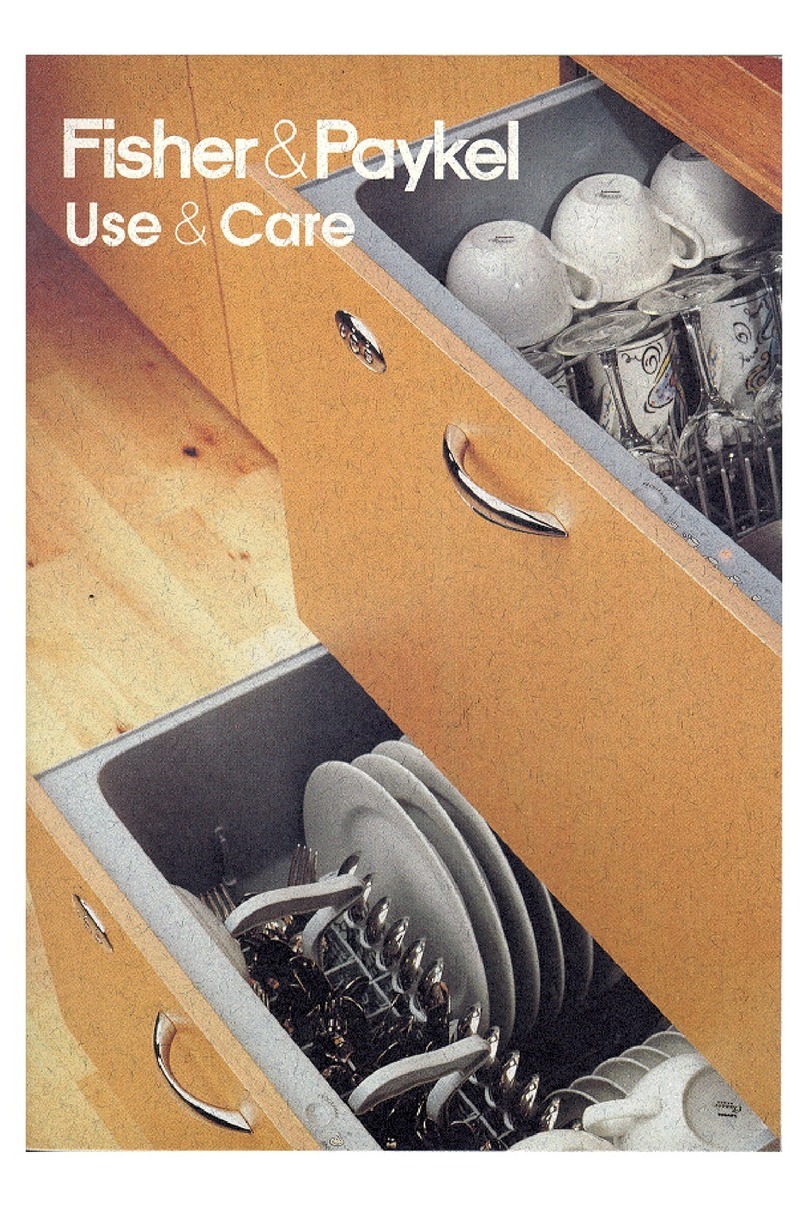
Fisher & Paykel
Fisher & Paykel DishDrawer DS602 Use and care guide
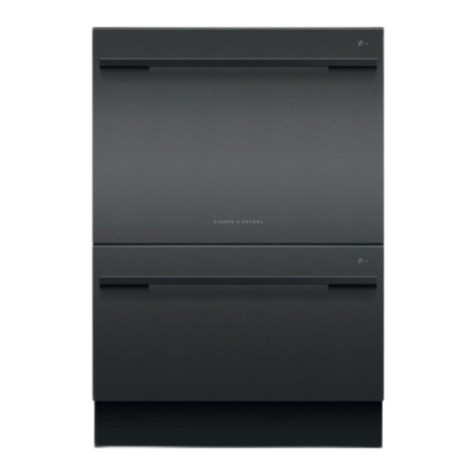
Fisher & Paykel
Fisher & Paykel DISHDRAWER DD24DDFTB9 Troubleshooting
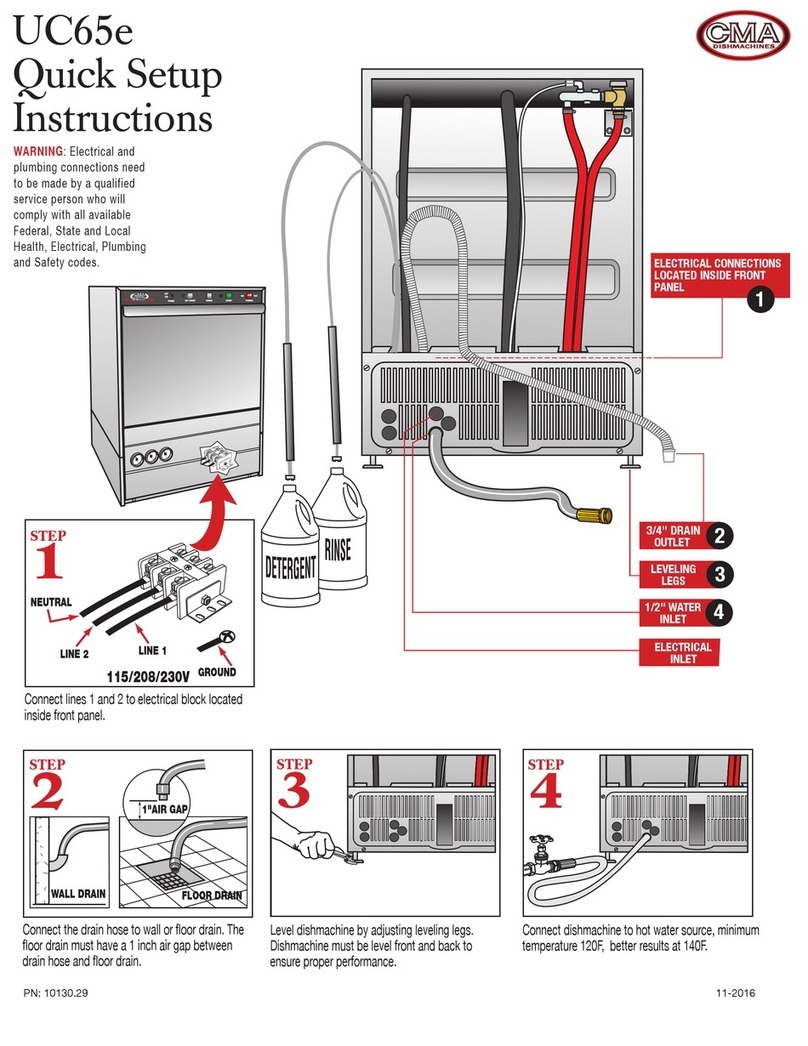
CMA Dishmachines
CMA Dishmachines UC65e Quick setup instructions

Frigidaire
Frigidaire LGID2478SF0A use & care

Frigidaire
Frigidaire FGIP2468UF use & care

Miele
Miele G 4570 operating instructions

